Click on images to enlarge
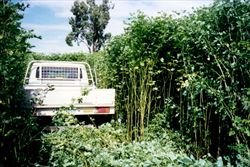
infestation (Photo: Land Protection, QDNRW)
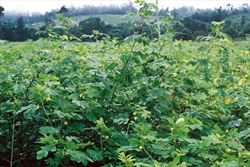
habit in flower (Photo: Land Protection, QDNRW)
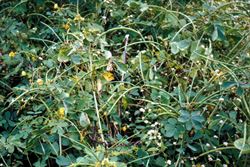
habit in fruit (Photo: Land Protection, QDNRW)
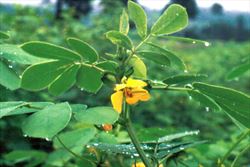
leaves and flowers (Photo: Land Protection, QDNRW)

once-compound leaves with several leaflets (Photo: Land Protection, QDNRW)
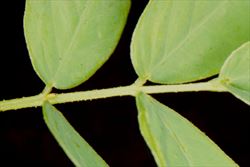
close-up of leaf showing glands (Photo: Marie Vitelli)

close-up of flower from side-on (Photo: Land Protection, QDNRW)
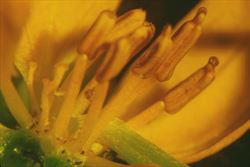
close-up of stamens showing beaked anthers (Photo: Marie Vitelli)
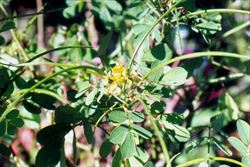
immature fruit (Photo: Land Protection, QDNRW)
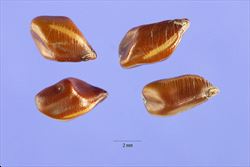
close-up of seeds (Photo: Steve Hurst at USDA PLANTS Database)
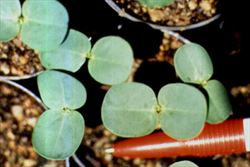
seedlings (Photo: Land Protection, QDNRW)
Scientific Name
Senna obtusifolia (L.) Irwin & Barneby
Synonyms
Cassia obtusifolia L.Cassia tora L. (misapplied)Cassia tora L. var. obtusifolia L.
Family
Caesalpiniaceae (Queensland, the ACT, Victoria, Tasmania, Western Australia and the Northern Territory)Fabaceae: sub-family Caesalpinioideae (New South Wales)Leguminosae (South Australia)
Common Names
arsenic weed, Chinese senna, coffee weed, coffeeweed, foetid cassia, Java bean, Java-bean, Javabean, sickle senna, sicklepod, sicklepod senna
Origin
This species is thought to be native to southern and eastern USA, Mexico, Central America, the Caribbean and tropical South America.
Naturalised Distribution
Sicklepod (Senna obtusifolia) is distributed mainly in the coastal and sub-coastal districts of northern Queensland and the Northern Territory. It has also been recorded in central Queensland and in the northern parts of Western Australia.
Also widely naturalised in other parts of the world including south-eastern Asia (i.e. the Philippines, Papua New Guinea, Indonesia, Malaysia and Vietnam) and Oceania (i.e. the Galapagos Islands, Palau and Hawaii).
Habitat
A weed of disturbed sites, waste areas, roadsides, waterways, floodplains, drainage channels, open woodlands, crops and pastures in wetter tropical and sub-tropical environments.
Habit
A short-lived (i.e. annual or biennial) shrub growing to up to 2.5 m tall, but usually less than 2 m in height.
Distinguishing Features
- a short-lived sprawling shrub growing up to 2.5 m tall.
- its compound leaves are borne on relatively short stalks and consist of two or three pairs of leaflets.
- there is a small elongated projection located between the lowest pair of leaflets on each leaf.
- its yellow flowers (10-15 mm across) are borne in pairs in the leaf forks and have five petals.
- its fruit is a slender, sickle-shaped, pod (6-18 cm long and 2-6 mm wide) that is usually curved downwards.
Stems and Leaves
Plants produce numerous, branched, sprawling stems that are 1.5-2 m long. These stems are usually softly hairy (i.e. pubescent) when young, but become mostly hairless (i.e. glabrescent) with age.
The compound (i.e. pinnate) leaves are alternately arranged along the stems and are borne on relatively short stalks (i.e. petioles) 15-20 mm long. They have two or three pairs of leaflets (17-65 mm long and 10-40 mm wide), with those further from the leaf stalk usually being larger. The leaflets are egg-shaped in outline with the narrower end attached to the stalk (i.e. obovate) and have rounded tips (i.e. obtuse apices). Their surfaces may be either hairless (i.e. glabrous) or sparsely hairy (i.e. pubescent) and the entire margins are usually edged with tiny hairs (i.e. cilia). There is a small elongated structure (i.e. gland) 1-3 mm long located on the main leaf axis (i.e rachis) between the lowest pair of leaflets (occasionally also between the second pair of leaflets as well).
Flowers and Fruit
The yellow flowers (10-15 mm across) are borne on stalks (i.e. pedicels) 7-28 mm long. These flowers usually occur in pairs in the leaf forks (i.e. axils) and are mostly located near the tips of the branches. They have five green sepals (5.5-9.5 mm long) and five yellow or pale yellow petals (8-15 mm long). Each flower also has seven fertile stamens with anthers (3-5 mm long) that have a short narrow projection (i.e. beak) on one end. Flowering occurs mostly from late summer through to late winter (i.e. from March to August).
The fruit is a slender, sickle-shaped (i.e. falcate), pod (6-18 cm long and 2-6 mm wide) that is almost round (i.e. cylindrical) in cross-section (sometimes slightly flattened or four-angled) and curved downwards. These pods turn brownish-green as they mature and are slightly indented between each of the numerous seeds (i.e. faintly septate). The seeds (3-6 mm long) are dark brown in colour, shiny in appearance, and either diamond-shaped (i.e. rhomboid) or irregular in shape.
Reproduction and Dispersal
This species reproduces only by seed.
Seeds are dispersed by water and animals that eat the fruit (e.g. cattle). They may also be spread as a contaminant of agricultural produce (i.e. fodder and pasture seeds) or in mud sticking to animals, footwear, machinery and vehicles.
Environmental Impact
Sicklepod (Senna obtusifolia) is regarded as an environmental weed in northern Queensland, the Northern Territory and northern Western Australia. It is actively managed by community groups in the Northern Territory.
Other Impacts
Legislation
This species is declared under legislation in the following states and territories:
- Northern Territory: B - spread to be controlled (throughout all of the Territory), and C - not to be introduced into the Territory.
- Queensland: Class 2 - landowners must take all reasonable steps to keep land free of this species (throughout the entire state). It is also illegal to sell a declared plant or its seed in this state.
- Western Australia: P1 - trade, sale or movement into the state prevented, and P2 - to be eradicated where found (throughout the entire state).
Management
For information on the management of this species see the following resources:
- the Biosecurity Queensland Fact Sheet on sicklepods, which is available online at http://www.dpi.qld.gov.au.
- the Northern Territory Department of Natural Resources, Environment and The Arts Agnote on this species, which is available online at http://www.nt.gov.au/weeds.
Similar Species
Sicklepod (Senna obtusifolia) is very similar to Java bean (Senna tora), hairy senna (Senna hirsuta), coffee senna (Senna occidentalis), smooth senna (Senna septemtrionalis) and the native arsenic bush (Senna planitiicola). It is also relatively similar to Easter cassia (Senna pendula var. glabrata) and pepper-leaved senna (Senna barclayana). These species can be distinguished by the following differences:
- sicklepod (Senna obtusifolia) is a relatively small slender shrub (usually 0.5-2 m tall) that has leaves with a few (2-3) pairs of leaflets. The relatively large leaflets (17-65 mm long) are relatively broad (15-40 mm wide) and have rounded tips (i.e. obtuse apices). Its flowers are borne in pairs in the leaf forks and the very elongated (6-18 cm long) pods are almost rounded in cross-section (i.e. cylindrical) and very narrow (2-6 mm wide). These pods are strongly curved downwards (i.e. sickle-shaped) and are mostly hairless (i.e. glabrous).
- Java bean (Senna tora) is a relatively small slender shrub (usually 0.5-2 m tall) that has leaves with a few (2-4) pairs of leaflets. The moderately-sized leaflets (10-40 mm long) are relatively broad (10-35 mm wide) and have rounded tips (i.e. obtuse apices). Its flowers are borne in pairs in the leaf forks and its very elongated (12-25 cm long) pods are almost rounded in cross-section (i.e. cylindrical) and very narrow (2-6 mm wide). These pods are strongly curved downwards (i.e. sickle-shaped) and are mostly hairless (i.e. glabrous). This species also gives off a strong unpleasant smell.
- hairy senna (Senna hirsuta) is a relatively small slender shrub (usually 0.5-2 m tall) that has leaves with several (2-6) pairs of leaflets. These relatively large leaflets (40-105 mm long) are relatively broad (20-40 mm wide) and have pointed tips (i.e. acute apices). Its flowers are borne in small clusters in the leaf forks and its very elongated (10-18 cm long) pods are usually somewhat flattened and very narrow (4-6 mm wide). These pods are slightly-curved downwards and are densely covered in long white hairs (i.e. pubescent).
- coffee senna (Senna occidentalis) is a relatively small slender shrub (usually 0.5-2 m tall) that has leaves with several (3-7) pairs of leaflets. The relatively large leaflets (30-100 mm long) are relatively broad (20-40 mm wide) and have pointed tips (i.e. acute apices). Its flowers are borne in small clusters in the leaf forks and its very elongated (7.5-13 cm long) pods are rounded (i.e. cylindrical) or slightly flattened and relatively thick (6-11 mm wide). These pods are straight or slightly-curved upwards and are mostly hairless (i.e. glabrous).
- smooth senna (Senna septemtrionalis) is a moderately-sized shrub (1-3 m tall) that has leaves with several (3-5) pairs of leaflets. The relatively large leaflets (45-70 mm long) are relatively broad (15-35 mm wide) and have pointed tips (i.e. acute apices). Its flowers are borne in relatively loose somewhat elongated many-flowered clusters (i.e. racemes) and its elongated (6-10.5 cm long) pods are almost rounded in cross-section (i.e. cylindrical) and relatively thick (10-15 mm wide). These pods are straight and mostly hairless (i.e. glabrous).
- arsenic bush (Senna planitiicola) is a relatively small slender shrub (usually 0.5-2 m tall) that has leaves with several (5-7) pairs of leaflets. The moderately-sized leaflets (25-50 mm long) are relatively broad (15-25 mm across) and have somewhat pointed tips (i.e. acute apices). Its flowers are borne in small clusters in the leaf forks and its relatively short (less than 8.5 cm long) pods are almost rounded in cross-section (i.e. cylindrical) and relatively thick (8-11 mm wide). These pods are straight and mostly hairless (i.e. glabrous).
- Easter cassia (Senna pendula var. glabrata) is a moderately-sized shrub (2-4 m tall) that has leaves with several (3-6) pairs of leaflets. The moderately-sized leaflets (20-50 mm long) are relatively broad (10-20 mm wide) with rounded tips (i.e. obtuse apices) and prominent yellowish coloured margins. Its flowers are borne in relatively loose leafy clusters and its elongated (10-20 cm long) pods are almost rounded in cross-section (i.e. cylindrical) and relatively thick (8-12 mm wide). These pods are relatively straight, sometimes have one or more constrictions, and are hairless (i.e. glabrous).
- pepper-leaved senna (Senna barclayana) is a low-growing shrub (usually less than 1 m tall) that has leaves with several (4-10) pairs of leaflets. The moderately-sized leaflets (20-50 mm long) are relatively narrow (4-15 mm wide) and have pointed tips (i.e. acute apices). Its flowers are borne in small clusters in the leaf forks and its relatively short (3-7 cm long) pods are almost rounded in cross-section (i.e. cylindrical) and relatively thick (6-9 mm wide). These pods are straight and hairless (i.e. glabrous).
There are many other native sennas (Senna spp.) that are also relatively similar to sicklepod (Senna obtusifolia). However, these species generally have thicker pods and ten fertile stamens in each flower.

